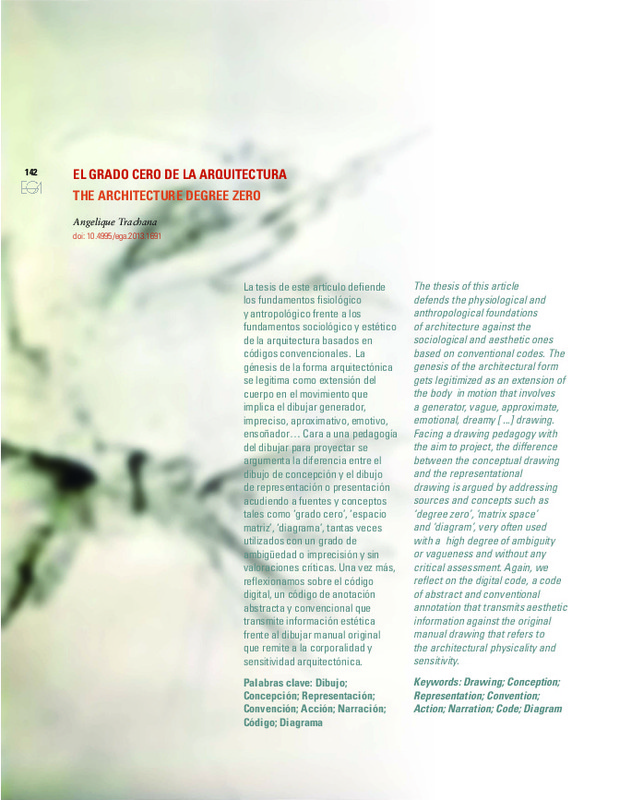JavaScript is disabled for your browser. Some features of this site may not work without it.
Buscar en RiuNet
Listar
Mi cuenta
Estadísticas
Ayuda RiuNet
Admin. UPV
El grado cero de la arquitectura
Mostrar el registro sencillo del ítem
Ficheros en el ítem
| dc.contributor.author | Trachana, Angelique
|
es_ES |
| dc.date.accessioned | 2016-12-23T10:47:32Z | |
| dc.date.available | 2016-12-23T10:47:32Z | |
| dc.date.issued | 2013-11-06 | |
| dc.identifier.issn | 1133-6137 | |
| dc.identifier.uri | http://hdl.handle.net/10251/75714 | |
| dc.description.abstract | [EN] The thesis of this article defends the physiological and anthropological foundations of architecture against the sociological and aesthetic ones based on conventional codes. The genesis of the architectural form gets legitimized as an extension of the body in motion that involves a generator, vague, approximate, emotional, dreamy [ ...] drawing. Facing a drawing pedagogy with the aim to project, the difference between the conceptual drawing and the representational drawing is argued by addressing sources and concepts such as ‘degree zero’, ‘matrix space’ and ‘diagram’, very often used with a high degree of ambiguity or vagueness and without any critical assessment. Again, we reflect on the digital code, a code of abstract and conventional annotation that transmits aesthetic information against the original manual drawing that refers to the architectural physicality and sensitivity | es_ES |
| dc.description.abstract | [ES] La tesis de este artículo defiende los fundamentos fisiológico y antropológico frente a los fundamentos sociológico y estético de la arquitectura basados en códigos convencionales. La génesis de la forma arquitectónica se legitima como extensión del cuerpo en el movimiento que implica el dibujar generador, impreciso, aproximativo, emotivo, ensoñador… Cara a una pedagogía del dibujar para proyectar se argumenta la diferencia entre el dibujo de concepción y el dibujo de representación o presentación acudiendo a fuentes y conceptos tales como ‘grado cero’, ‘espacio matriz’, ‘diagrama’, tantas veces utilizados con un grado de ambigüedad o imprecisión y sin valoraciones críticas. Una vez más, reflexionamos sobre el código digital, un código de anotación abstracta y convencional que transmite información estética frente al dibujar manual original que remite a la corporalidad y sensitividad arquitectónica | es_ES |
| dc.language | Español | es_ES |
| dc.language | Inglés | es_ES |
| dc.publisher | Universitat Politècnica de València | |
| dc.relation.ispartof | EGA. Revista de Expresión Gráfica Arquitectónica | |
| dc.rights | Reserva de todos los derechos | es_ES |
| dc.subject | Dibujo | es_ES |
| dc.subject | Drawing | es_ES |
| dc.subject | Arquitectura | es_ES |
| dc.subject | Architecture | es_ES |
| dc.subject | Representación | es_ES |
| dc.subject | Convención | es_ES |
| dc.subject | Acción | |
| dc.subject | Narración | |
| dc.subject | Código | |
| dc.subject | Diagrama | |
| dc.title | El grado cero de la arquitectura | es_ES |
| dc.title.alternative | THE ARCHITECTURE DEGREE ZERO | es_ES |
| dc.type | Artículo | es_ES |
| dc.date.updated | 2016-12-23T08:41:38Z | |
| dc.identifier.doi | 10.4995/ega.2013.1691 | |
| dc.rights.accessRights | Abierto | es_ES |
| dc.description.bibliographicCitation | Trachana, A. (2013). El grado cero de la arquitectura. EGA. Revista de Expresión Gráfica Arquitectónica. 18(22):142-153. https://doi.org/10.4995/ega.2013.1691 | es_ES |
| dc.description.accrualMethod | SWORD | es_ES |
| dc.relation.publisherversion | https://doi.org/10.4995/ega.2013.1691 | es_ES |
| dc.description.upvformatpinicio | 142 | es_ES |
| dc.description.upvformatpfin | 153 | es_ES |
| dc.type.version | info:eu-repo/semantics/publishedVersion | es_ES |
| dc.description.volume | 18 | |
| dc.description.issue | 22 | |
| dc.identifier.eissn | 2254-6103 | |
| dc.description.references | Armstrong, D. F., Stokoe, W. C., & Wilcox, S. E. (1995). Gesture and the Nature of Language. doi:10.1017/cbo9780511620911 | es_ES |
| dc.description.references | – BONTA, J. P. 1977. Sistemas de significación en arquitectura. Barcelona: G. Gili. | es_ES |








